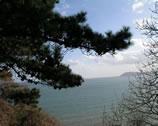

IRELAND’S NATURAL SUPERLATIVES
Highest point – the biggest mountain on the island of Ireland is Carrantuohill in the MacGillycuddy’s Reeks, Co Kerry at 3414ft (1041 m)
The highest point in Nothern Ireland is Slieve Donard, the tallest of the Mourne Mountains in Co Down at 2789ft (850 m).
Lowest point – No point on the island is below sea level.
Longest river – The Shannon is the longest river in Ireland. It rises 258ft (79 m) above sea level in Co Cavan and flows 240 miles (386 km), including a 56 mile ( 90 km) estuary, to Loop Head and the Atlantic Ocean. The Shannon is longer than any river in the British Isles.
Largest Lake – The largest lake in Ireland is Lough Neagh (also the largest in the British Isles). It is bordered by all the counties of Northern Ireland excluding Fermanagh, is 18 miles (29 km) long and 11 miles (17.7 km) wide. It encompasses an area of 147.39 miles sq (381.73 km sq). Its deepest point is 102ft (31m) and it is 48ft (14.6) above sea level. Approximately one third of the area of County Fermanagh is water.
Highest waterfall – the highest waterfall in Ireland is the Powerscourt Waterfall, 350ft (106 m), on the River Dargle in Co Wicklow.
Highest cliffs – the highest cliffs in Ireland rise 2192ft (668 m) sheer above the sea at Croaghan on the north coast of Achill Island, Co Mayo. These are the highest cliffs in north-west Europe. Slieve League mountain, in south-west Co Donegal rises 1971ft (601 m) sheer above the Atlantic ocean.
Longest stalactite – the longest free-handing stalactite known is one of 20ft 4in (6.2 m) in the Pollan Lonain cave in Co Clare. Stalactites supported artificially or by cave walls can grow longer.
Earthquakes – no earthquake with its epicentre in Ireland has ever been recorded instrumentally. A shock, reported in August 1734, caused damage to 100 houses and 5 churches. More recently, the highest instrumentally recorded quake in Great Britain (on land) which felt on the coast of Ireland and caused minor structural damage. Statistically, Ireland is the safest place in the world to avoid earthquakes.
Temperature – highest recorded. The highest shade temperature ever recorded in Ireland since records began in 1881 was 92 F/33.3 C at Kilkenny Castle on 26 June 1887.
Lowest recorded. The lowest air temperature ever recorded in Ireland was –2.92F/ -19.4 C at Omagh, Co Tyrone on 23 Januare 1881.
Rainfall – the most intense fall of rain recorded in Ireland occurred in Orra Beg, Co Antrim on 1 August 1980 when 3.82in (97mm) of rain fell in just 45 minutes. On 26 August 1949, 1.5in (38mm) of rain fell in 12 minutes at Waterford.
The storm of 25/26 August 1986 set new precipitation records nationwide. Kippure Mountain, Co Wicklow (754m) recorded a fall of 10.63in (270mm) in a 24 hour period.
The number of days on which rain falls in Ireland is generally high in comparison with other countries. Ballynahinch, Co Galway recorded rainfall on 309 days in the calendar year 1923-the most rainy days in one year recorded in Ireland and Britain.
The driest year on record was 1887 when a mere 14in (356.6mm) of rain fell in Dublin.
The longest drought recorded lasted from 3 April to 10 May 1938 at Mulgrave Street weather station in Limerick.
Snowfall – the heaviest snowfalls recorded in Ireland occurred in 1917. On 25/26 January, the south and west experienced a storm that deposited 23.6in (0.6m) over much of the south and west of the country while drifts of 177.5in (4.5m) were observed in Co Mayo. 1 April of the same year saw even more severe falls with snow covering the country to depths of 51.2in (1.3m) with 118.2in (3.0m) drifts.
Windspeed – the most damaging storm in Irish history occurred on 6/7 January 1839. Windspeeds on
A severe storm which passed over Ireland on 11/12 January 1974 produced a gust of 108 knots at Kilkeel, Co Down, the highest ever recorded for a station at sea level in Ireland.
Sunshine – the southeast corner is the sunniest area of Ireland. In 1959, Rosslare experienced the sunniest year on record with 1996.4 hours. A monthly total of more than 250 hours is extremely rare. However, Valentia Observatory recorded 308.2 hours of sunshine in July 1955. Glencolumbkille, Co Donegal experienced a mere 6.4 hours in the month of January 1974.
Used information:
The Guinness book of Irish facts & feats
Ciaran Deane (in association with the Irish Tourist Board)